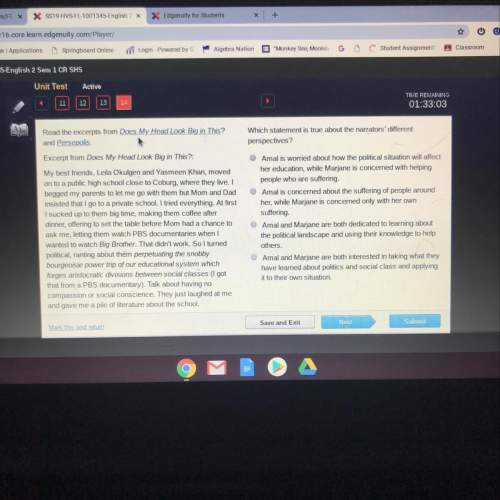
English, 10.10.2019 09:30 olgapagan1010
Read the excerpt from "annabel lee," by edgar allan poe. it was many and many a year ago, in a kingdom by the sea, that a maiden there lived whom you may know by the name of annabel lee; and this maiden she lived with no other thought than to love and be loved by me. how does the rhythm of the excerpt support the theme of the poem? the rhythm is consistent, and poe celebrates the predictability of history. the rhythm is consistent, and poe celebrates the simplicity of young love. the rhythm is unpredictable, and poe warns readers to guard their hearts. the rhythm is unpredictable, and poe warns readers of nature’s

Answers: 3


Another question on English

English, 21.06.2019 19:30
What is the significance of the novel's title? what is the "sweet hereafter"? a). a place you go after a tragedy takes your life b). a beautiful place the dead go, like heaven c). into the sunset, an ending that is not defined d). a dark sad place the dead go before rebirth
Answers: 2


English, 22.06.2019 04:50
Read the passage, then answer the question that follows. no one could have seen it at the time, but the invention of beet sugar was not just a challenge to cane. it was a hint—just a glimpse, like a twist that comes about two thirds of the way through a movie—that the end of the age of sugar was in sight. for beet sugar showed that in order to create that perfect sweetness you did not need slaves, you did not need plantations, in fact you did not even need cane. beet sugar was a foreshadowing of what we have today: the age of science, in which sweetness is a product of chemistry, not whips. in 1854 only 11 percent of world sugar production came from beets. by 1899 the percentage had risen to about 65 percent. and beet sugar was just the first challenge to cane. by 1879 chemists discovered saccharine—a laboratory-created substance that is several hundred times sweeter than natural sugar. today the sweeteners used in the foods you eat may come from corn (high-fructose corn syrup), from fruit (fructose), or directly from the lab (for example, aspartame, invented in 1965, or sucralose—splenda—created in 1976). brazil is the land that imported more africans than any other to work on sugar plantations, and in brazil the soil is still perfect for sugar. cane grows in brazil today, but not always for sugar. instead, cane is often used to create ethanol, much as corn farmers in america now convert their harvest into fuel. –sugar changed the world, marc aronson and marina budhos how does this passage support the claim that sugar was tied to the struggle for freedom? it shows that the invention of beet sugar created competition for cane sugar. it shows that technology had a role in changing how we sweeten our foods. it shows that the beet sugar trade provided jobs for formerly enslaved workers. it shows that sweeteners did not need to be the product of sugar plantations and slavery.
Answers: 1

English, 22.06.2019 06:00
Drag the tiles to the boxes to form correct pairs. match each word with its synonym irate wasteful unmerciful headstrong extravagant stubborn heartless angry
Answers: 1
You know the right answer?
Read the excerpt from "annabel lee," by edgar allan poe. it was many and many a year ago, in a kingd...
Questions





Mathematics, 13.01.2021 17:40

Mathematics, 13.01.2021 17:40



Geography, 13.01.2021 17:40



Computers and Technology, 13.01.2021 17:40




Mathematics, 13.01.2021 17:40

History, 13.01.2021 17:40


Mathematics, 13.01.2021 17:40

Mathematics, 13.01.2021 17:40




